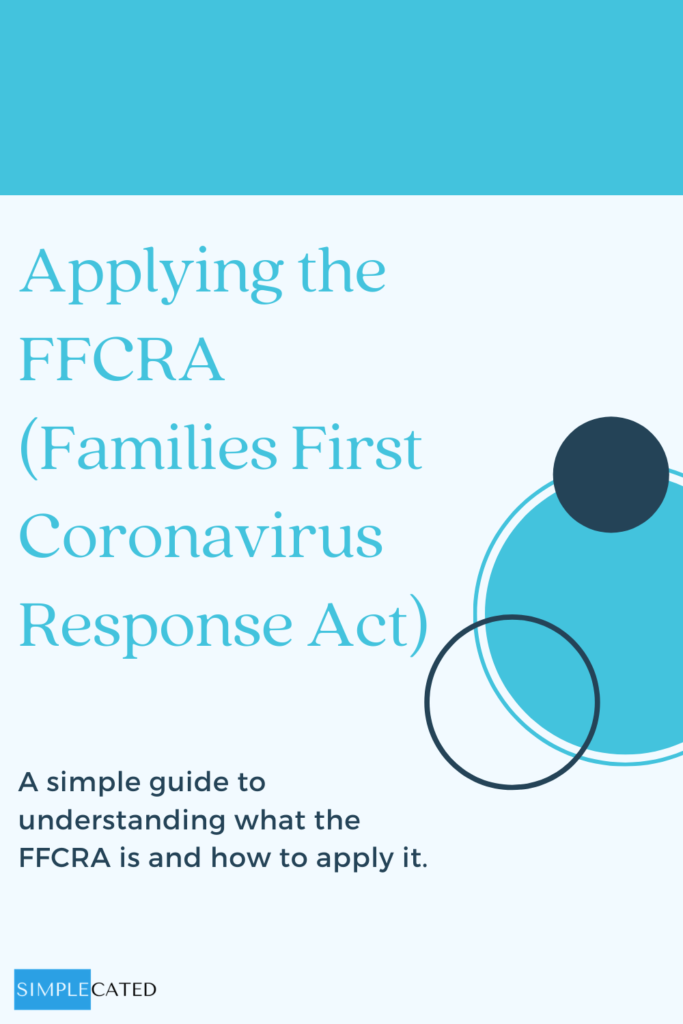Today (April 1, 2020), the Families First Coronavirus Response Act (FFCRA) goes into effect. So, what is the FFCRA? It provides paid leave to those who are employed by businesses that have fewer than 500 employees in an effort to help those who need to take time off of work related to the COVID-19 illness or the related school and daycare closures. It applies to private employers as well as some public employers. The FFCRA applies to 2 types of leave taken April 1 – December 31, 2020.
- Employees receive 2 weeks of paid sick leave if they are unable to work or telework due to being quarantined or experiencing COVID-19 symptoms and seeking a diagnosis. For employees who are needing to care for someone who is quarantined or care for a child whose school or child care provider is closed or unavailable due to COVID-19, they receive 2 weeks of paid sick leave at two-thirds their regular rate of pay.
- For employees who have been employed for at least 30 days, there is an additional benefit provided. They can receive up to 10 weeks of “paid expanded family and medical leave” if they have “a bona fide need for leave to care for a child whose school or child care provider is closed or unavailable for reasons related to COVID-19.” They can receive this at two-thirds their regular rate of pay.
This is basically an expansion of FMLA, so the best people to administer this at your company are those who also handle any FMLA requests. Here are some important things to know about applying the FFCRA:
- These benefits apply to employees who are unable to work or telework.
- Paid sick leave is capped at 2 weeks for any combination of the qualifying reasons. So, for example, an employee who already took 2 weeks of paid sick leave to care for someone else and is later advised to quarantine has already exhausted the sick leave provided under the FFCRA and isn’t eligible for more.
- Regarding the extended family leave, the FFCRA provides a total of 12 weeks for needing to care for a child. The first 2 weeks are unpaid, and then 10 weeks are paid at two-thirds the regular rate of pay. For those first 2 weeks, employees have the option to use the FFCRA’s paid sick leave benefit (if they haven’t already used it for another reason) or to use employer-provided benefits, such as accrued vacation or sick leave. Think about this as an extension of FMLA. During a 12-month period, employees are eligible for 12 weeks total of FMLA (either regular or extended). If an employee has already exhausted 12 weeks of regular FMLA, he or she isn’t eligible for extended FMLA (he or she could still use the paid sick leave benefit).
- For both paid sick leave and extended family leave, you’ll use the FMLA’s definition of “child,” which can include individuals older than 18 who have a disability and are unable to care for themselves.
- Paid sick leave is capped at 80 hours total for the 2 weeks, but this doesn’t necessarily mean 40 hours per week if you have an employee who would have been scheduled for overtime. Guidance has been provided on the calculations for overtime and for leave for part-time employees.
- Employers can be reimbursed through tax credits for all qualifying wages they pay and for the cost of maintaining health coverage. Note that there are payment caps on what’s considered a “qualifying wage” under the FFCRA. With the 2-week sick leave component, employees taking leave for themselves receive their regular rate of pay up to $511 per day and $5,110 total, while those taking care of someone else receive two-thirds their regular rate of pay up to $200 per day and $2,000 total. For those eligible for the 10 weeks of extended family leave, they can receive up to $200 per day and $10,000 total.
- Just like with any leave, you should request documentation from your employees who request it, and some guidance has been provided from the IRS. This will help you when claiming tax credits as well as help you administer these benefits consistently. For paid sick leave requests, consider using the same healthcare provider certification form you use for FMLA. For child care-related leave, request documentation of the closure and that no one else will be providing care for the child during the leave.
- If you employ health care providers or emergency responders, you have the option of not providing the sick leave or extended family leave to them. You will want to think very carefully about this. We all know how much we’re relying on these individuals to keep us safe and take care of us right now. At the same time, we want to be sure we’re taking care of them as much as possible and also not creating a dynamic where they potentially continue coming to work while ill.
- If you have fewer than 50 employees, some of the FFCRA may not apply to you, particularly the requirement to provide leave to care for a child if it would “jeopardize the viability of the business as a going concern.” However, again, you’d want to think very carefully about the ramifications of not providing this kind of very necessary benefit. If you don’t provide it, you run the risk of losing your employees, and you send the message you don’t care about the needs of working parents (not to mention the impact on your company’s reputation for not providing support during this challenging pandemic), which could present an even greater challenge to your business.
- This is the minimum that has to be provided. You can always provide more generous benefits to your employees.
The FFCRA provides a helpful paid leave benefit during this challenging time, and it’s one of the things employers can provide to help working parents. It’s also an important reminder of the necessity of providing some kind of paid sick leave to employees. Even outside of a pandemic, providing paid sick leave to your employees enables them to take care of their wellbeing while not worrying about their jobs. Plus, if sick employees stay home, it helps keep your other employees well! If your company doesn’t currently provide paid sick leave (or paid family leave), I’d strongly encourage you to consider adding this benefit in the future.
Photo credit: By ilyaska / Canva





